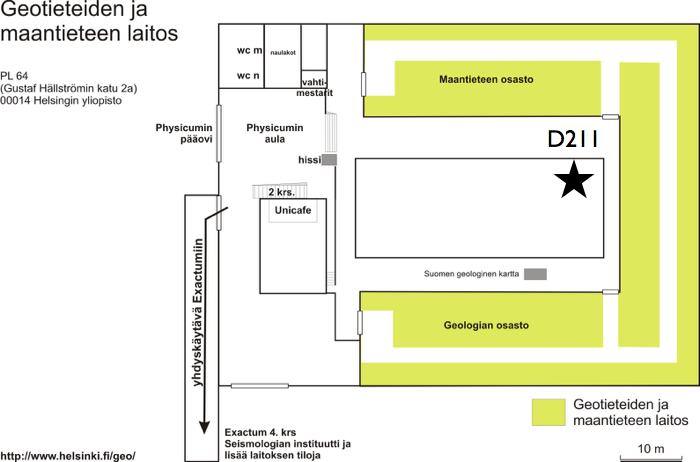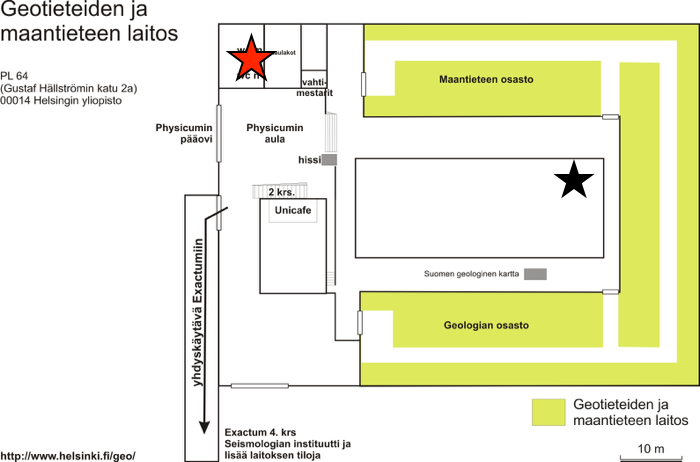Course overview¶
Lars Kaislaniemi and David Whipp
14-18 May 2018
Let’s get to know one another¶
Who are we?¶
- Dave Whipp, Associate professor
- Geodynamics of convergent orogens
- Geomorphology
- Lars Kaislaniemi, Postdoctoral researcher
- Geodynamics of the Bolivian Andes
- Mantle dynamics and geochemistry
Who are you?¶
Name
Home university & program
Status (Ph.D., MSc, etc.)
Thesis topic
Experience with coding and/or modelling
Practical matters¶
Where are we?¶

D211
Toilets¶

Toilets
Coffee/tea¶

Coffee/tea
Lunch¶
<li>You can get a <b>full hot lunch</b> at the Chemicum, Excatum, or Dynamicum (pricier, but a bit better).</li>
<li>The Unicafe (coffee / tea spot) also has <b>sandwiches / paninis</b></li>
Computer stuff and course website¶
Computers in this classroom¶
- It’s best if you use your own computer for this course
- Computers in this classroom can also be used, but require a University of Helsinki IT account
Software¶
- All software used in this course is freely available
- A list of software available for download is provided on the course website (next slide)
Course website¶
- All course materials will be posted to the course website:
https://introgm.github.io
- This page will provide links to lecture slides, scripts used for the course, and other materials
- We will be updating the page as we go.
- The materials are freely available for use by anyone, subject to the license, so feel free to share with your friends/colleagues!
Course goals and learning objectives¶
Course goals¶
- Understand the fundamental physical equations solved in numerical geodynamic models, how they work, and how they affect numerical experiments
- Learn how to convert the main equations used to model lithospheric deformation into simple programs
- Develop a background understanding of geodynamics that allows you to properly understand the behavior of geodynamic numerical models
Learning objectives¶
At the end of this course, students should be able to:
- Solve partial differential equations using the finite-difference method
- Differentiate between and implement various boundary and initial conditions in numerical models
- Create their own 1D geodynamic models and know how to use modern 3D numerical geodynamic modelling software to simulate common physical processes in the Earth (heat transfer, rock deformation, etc.)
Working methods¶
The course involves a combination of lectures and computer-based exercises
- We will try to keep lectures to a minimum, but we do need to present some material you will need to complete the computer exercises
- For the computer exercises, you should work together with the others in the course and we will discuss your solutions after you have completed each exercise
Schedule¶
*Subject to change - Last updated 15.5.2018*
*Press space to view each day*
Day 1¶
09:30-10:00 - Course overview and introductions 10:00-10:50 - Key physical processes/concepts
10:50-11:05 - *Coffee/tea break*
11:05-11:45 - Key physical processes/concepts (ctd.) 11:45-12:15 - Solving equations 12:15-12:30 - Computer setup/introduction (optional)
12:30-13:30 - *Lunch*
13:30-14:50 - Python/computing essentials
14:50-15:05 - *Coffee/tea break*
15:05-16:30 - Python/computing essentials (ctd.)
Day 2¶
09:30-10:50 - The finite difference method, part I
10:50-11:05 - *Coffee/tea break*
11:05-12:30 - The finite difference method, part I (ctd.)
12:30-13:30 - *Lunch*
13:30-15:00 - Heat conduction and advection in 1D
15:00-15:15 - *Coffee/tea break*
15:15-16:30 - Heat conduction and advection in 1D (ctd.)
Day 3¶
09:30-10:50 - Testing your code and benchmarking
10:50-11:05 - *Coffee/tea break*
11:05-12:30 - Solving the momentum and continuity equations
12:30-13:30 - *Lunch*
13:30-15:00 - Solving the momentum and continuity equations (ctd.)
15:00-15:15 - *Coffee/tea break*
15:15-16:30 - Free working time
Day 4¶
09:30-10:50 - Introduction to DOUAR
10:50-11:05 - *Coffee/tea break*
11:05-12:30 - Cluster computing
12:30-13:30 - *Lunch*
13:30-15:00 - Running a DOUAR model
15:00-15:15 - *Coffee/tea break*
15:15-16:30 - 3D visualization with ParaView
Day 5¶
09:30-10:50 - Modifying the DOUAR models and re-running experiments
10:50-11:05 - *Coffee/tea break*
11:05-12:30 - Modifying the DOUAR models and re-running experiments (ctd.)
12:30-13:30 - *Lunch*
13:30-13:45 - Course project description 13:45-15:00 - Free time for experimentation with DOUAR
15:00-15:15 - *Coffee/tea break*
15:15-16:30 - Free time for experimentation with DOUAR (ctd.)